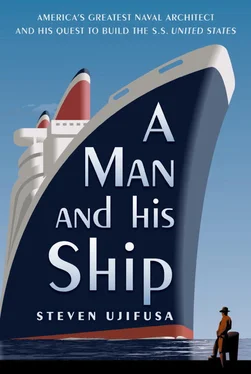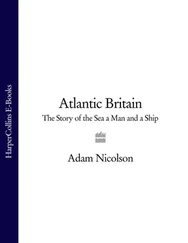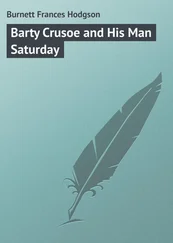While on the witness stand, Philip Franklin swore under oath that he first learned about the sinking at 6:16 P.M. on April 15, less than two hours after a young radio operator atop Wanamaker’s department store named David Sarnoff picked up a faint message from Titanic ’s sister ship, Olympic: “Please allay rumors that the Virginian has any of Titanic ’s survivors. I believe they are all aboard the Carpathia. ” 10 Carpathia ’s captain had refused to answer incoming radio messages for much of her return voyage to New York, deciding instead to send out lists of the saved.
After hearing Franklin’s testimony, Senator Smith concluded that IMM vice president Philip Franklin did not withhold news about Titanic ’s sinking.
On May 25, as the hearings were winding down, Captain Herbert James Haddock of Titanic’s sister ship, Olympic, phoned Franklin at White Star Line headquarters. Smith had showed up at the pier completely unannounced. He wanted to inspect Olympic.
Franklin said that he would get to Pier 59 as soon as he could. In the meantime, he ordered Olympic ’s captain and crew to do whatever the senator asked.
Smith was not alone that morning. With him were Rear Admiral Richard M. Watt—chief constructor (head of design) for the United States Navy—and a stenographer. After taking sworn testimony from Olympic ’s officers and crew, the senator walked the decks. He eyed the forty-three lifeboats and rafts set hard by each other along the boat deck. Before Titanic sank, Olympic carried just sixteen emergency craft. Smith pointed at one of the lifeboats and asked Captain Haddock if he could have it swung out. It was, and all watched it swaying in the spring breeze sixty feet above the Hudson. Haddock hoped that the senator was satisfied. He wasn’t. Smith then asked the captain to load the boat with sixty-five men from Olympic ’s crew and lower it into the Hudson.
Haddock froze for a moment, but then remembered Franklin’s order: do whatever the senator asks. One by one, members of Olympic ’s crew stepped across the gap and took a seat in the dangling lifeboat. Senator Smith took out his pocket watch. When the lifeboat splashed into the Hudson River, the senator noted that it had taken eighteen minutes to swing out, load, and lower the boat. He seemed satisfied.
As Smith and Watt continued to inspect the White Star ship, an out-of-breath Philip Franklin jogged up the gangway leading to Olympic. He rushed up the grand staircase, passing the grand clock with the three allegorical figures of “Honor” and “Glory” crowning “Time.” Once on the boat deck, he could see light streaming in through a glass dome and onto the fine-grained panels, white tiled floors, and gilded balustrades—almost exactly as it once did on Titanic. Ahead he saw a knot of men standing around Senator Smith, who continued his probe.
The group descended into the depths of the vessel, first through luxurious public rooms and foyers, down deep-carpeted corridors, and then into the stark service areas. Finally, the men walked down a steel staircase into one of Olympic ’s six boiler rooms, thirty feet below the waterline. As they entered the towering but dimly lit space, all gasped for air as acrid clouds of coal dust tore at their throats. The ship’s boilers were still aglow and the temperature hovered around 100 degrees. Through the murk, the senator saw dozens of sweaty, soot-smeared men lined up and at work. They pushed their shovels into piles of coal, tossed their loads into the blazing furnaces, and then clanged their shovels on the grates after every scoop thrown in. Even though the ship was in port, the boilers still provided electrical power for the ship’s mechanical systems.
“I found the head firemen of the Titanic, ” Senator Smith recalled, “and there in the grease and the heat, by a dim light and surrounded by his companions, he swore that he was the first man to see the water come through the sides of the stricken ship. He said that the tear extended through the side of the forward fire room… that the water came from a point about 20 feet below the sea level, and rushed like a mighty torrent into the ship.” 11
Frederick Barrett, one of the few stokers who survived, had been put right back to work on Titanic ’s sister ship. Barrett told Smith that 24 of the ship’s 29 boilers were fired at the time of collision, and that the ship was barreling along at “best speed she had ever shown.” 12
Smith finally had firsthand confirmation that Titanic was plowing ahead at full speed into the ice field.
Three days later, on May 28, 1912, Senator Smith presented his findings to a joint session of Congress. Despite the terrible loss of life, the American inquiry could not find IMM guilty of negligence, because the company had broken no existing laws. But this did not stop Senator Smith from blasting the arrogance of Titanic ’s designers and owners.
Smith then called for the rebuilding of the American merchant marine and urged that “Americans must reenlist in this service; they must become the soldiers of the sea…. Their rights must be respected and their work carefully performed.” 13
After he finished, the senator put forward a bill that would create a new Maritime Commission for the purpose of drafting new legislation regulating safety at sea for all ships using American ports. Congress quickly passed it. 14
Smith’s bill also created the International Convention for the Safety of Life at Sea, charged with writing a treaty that would compel seafaring nations to set construction and safety standards for new passenger liners. President Taft, who lost a close advisor in the disaster, quickly signed the Smith bill into law.
When the International Convention for the Safety of Life at Sea (SOLAS) met in London in November 1913, Britain, the United States, and other seafaring nations agreed to require all vessels to carry enough lifeboats for all passengers and crew. The SOLAS treaty also required that masters reduce speed and change course in the event of ice warnings, and that all liners carrying more than fifty passengers have wireless sets manned around the clock. Finally, the treaty called for the creation of the International Ice Patrol. Funded by all participating nations, patrol ships would alert approaching vessels about icebergs that had drifted into Atlantic shipping lanes. 15
The British public was incensed at an American effort to speak to what they believed, incorrectly, was the sinking of a British ship—she was in fact wholly owned by J. P. Morgan’s American trust, and only flagged as British to avoid higher American operating costs. The Saturday Review wrote that Senator Smith of Michigan was “the man that we describe in England as an ass.” 16
The disaster devastated those who had invested in the International Mercantile Marine. Seven months after Titanic went down, Clement Griscom, the profane Quaker tycoon who launched the United Gas Improvement Company with William Warren Gibbs and who convinced J. P. Morgan to organize IMM, collapsed of a stroke and died at age seventy-two. Peter Widener suffered the greatest loss: his son George and grandson Harry (three years ahead of William Francis Gibbs at Harvard) were killed in the disaster.
J. P. Morgan, who had canceled his reservation aboard the Titanic at the last minute, died a morose and vilified man at age seventy-six in the spring of 1913. The last year of his life had seen not only the Titanic disaster, but the antitrust Pujo hearings in Washington, as a House committee investigated how the old man’s bank did business. His son Jack hovered around his ailing father, who seethed with rage all during the inquiry.
Читать дальше












